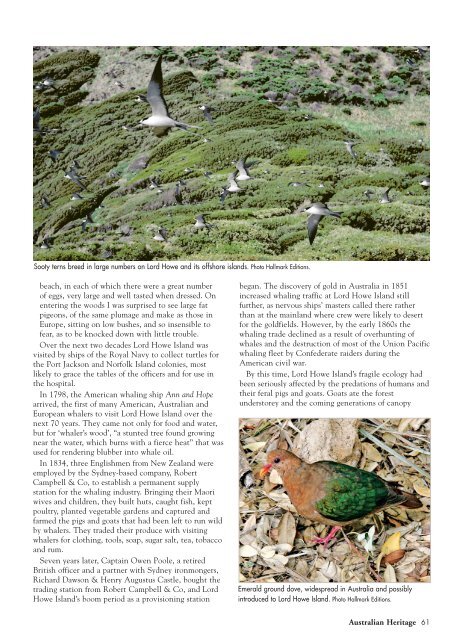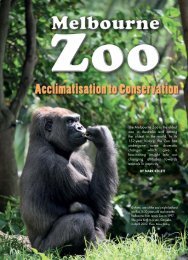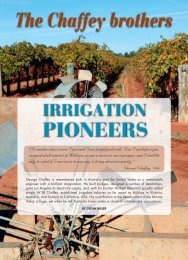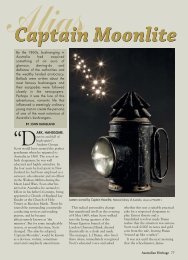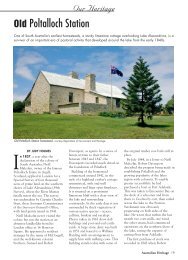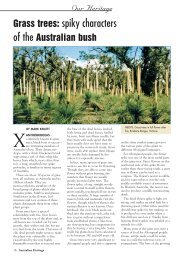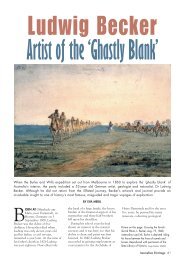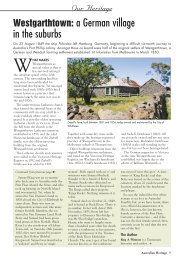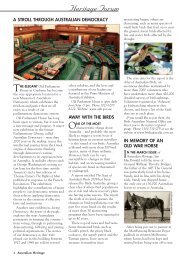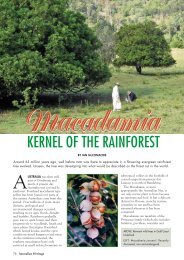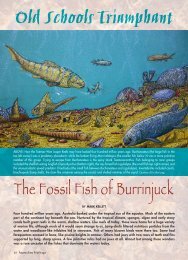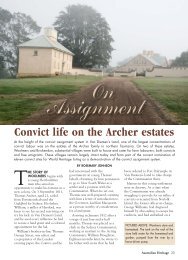Heritage 0609_Lord Howe.pdf - Australian Heritage Magazine
Heritage 0609_Lord Howe.pdf - Australian Heritage Magazine
Heritage 0609_Lord Howe.pdf - Australian Heritage Magazine
Create successful ePaper yourself
Turn your PDF publications into a flip-book with our unique Google optimized e-Paper software.
Sooty terns breed in large numbers on <strong>Lord</strong> <strong>Howe</strong> and its offshore islands. Photo Hallmark Editions.<br />
beach, in each of which there were a great number<br />
of eggs, very large and well tasted when dressed. On<br />
entering the woods I was surprised to see large fat<br />
pigeons, of the same plumage and make as those in<br />
Europe, sitting on low bushes, and so insensible to<br />
fear, as to be knocked down with little trouble.<br />
Over the next two decades <strong>Lord</strong> <strong>Howe</strong> Island was<br />
visited by ships of the Royal Navy to collect turtles for<br />
the Port Jackson and Norfolk Island colonies, most<br />
likely to grace the tables of the officers and for use in<br />
the hospital.<br />
In 1798, the American whaling ship Ann and Hope<br />
arrived, the first of many American, <strong>Australian</strong> and<br />
European whalers to visit <strong>Lord</strong> <strong>Howe</strong> Island over the<br />
next 70 years. They came not only for food and water,<br />
but for ‘whaler’s wood’, “a stunted tree found growing<br />
near the water, which burns with a fierce heat” that was<br />
used for rendering blubber into whale oil.<br />
In 1834, three Englishmen from New Zealand were<br />
employed by the Sydney-based company, Robert<br />
Campbell & Co, to establish a permanent supply<br />
station for the whaling industry. Bringing their Maori<br />
wives and children, they built huts, caught fish, kept<br />
poultry, planted vegetable gardens and captured and<br />
farmed the pigs and goats that had been left to run wild<br />
by whalers. They traded their produce with visiting<br />
whalers for clothing, tools, soap, sugar salt, tea, tobacco<br />
and rum.<br />
Seven years later, Captain Owen Poole, a retired<br />
British officer and a partner with Sydney ironmongers,<br />
Richard Dawson & Henry Augustus Castle, bought the<br />
trading station from Robert Campbell & Co, and <strong>Lord</strong><br />
<strong>Howe</strong> Island’s boom period as a provisioning station<br />
began. The discovery of gold in Australia in 1851<br />
increased whaling traffic at <strong>Lord</strong> <strong>Howe</strong> Island still<br />
further, as nervous ships’ masters called there rather<br />
than at the mainland where crew were likely to desert<br />
for the goldfields. <strong>Howe</strong>ver, by the early 1860s the<br />
whaling trade declined as a result of overhunting of<br />
whales and the destruction of most of the Union Pacific<br />
whaling fleet by Confederate raiders during the<br />
American civil war.<br />
By this time, <strong>Lord</strong> <strong>Howe</strong> Island’s fragile ecology had<br />
been seriously affected by the predations of humans and<br />
their feral pigs and goats. Goats ate the forest<br />
understorey and the coming generations of canopy<br />
Emerald ground dove, widespread in Australia and possibly<br />
introduced to <strong>Lord</strong> <strong>Howe</strong> Island. Photo Hallmark Editions.<br />
<strong>Australian</strong> <strong>Heritage</strong> 61


